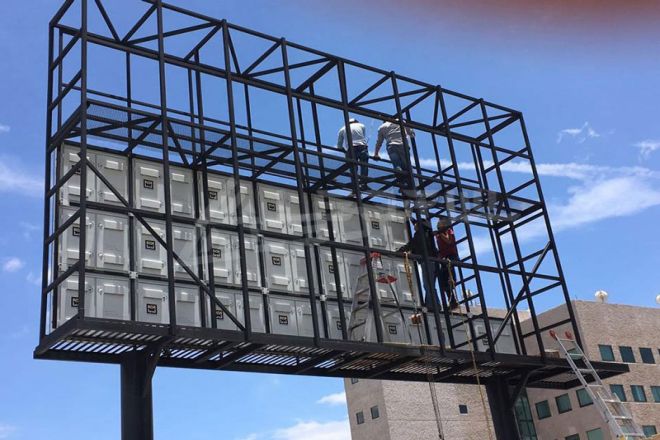In reality, most installation problems arise long before the first module is hoisted. These problems stem from incomplete site data, insufficient assumptions about structural dimensions or sunlight exposure, and unclear division of responsibilities between the transparent LED display supplier, curtain wall contractor, and building owner. Actual project data shows that over half of post-installation failures are related to mechanical installation errors or inadequate environmental planning. Therefore, our mitigation measures incorporate measured inputs: accurate curtain wall geometry, validated wind load values, realistic solar and thermal forecasts, and a clear operational plan.
Site Assessment and Glass Curtain Wall Planning Pitfalls for Transparent LED Display Installations
One of the earliest and most common mistakes is underestimating the actual site requirements. Transparent LED displays installed on or within glass curtain walls perform differently from traditional backlit displays. First, we don’t rely solely on architectural drawings; we conduct a site survey. We measure the curvature of the curtain wall, glass thickness, mullion spacing, and gaps. We also check the exact location of HVAC louvres, window washers, and emergency exits to ensure the LED displays don’t obstruct critical building systems or violate local codes.
Furthermore, excessive direct sunlight can reduce contrast, increase module temperatures, and shorten the lifespan of LED displays. During installation, we collect local solar irradiance data for the worst months and times of the year to determine the size of sunshades, anti-glare films, or high-brightness modules. Furthermore, when transparent LED displays are installed behind glass, we also consider the indoor environment. Finally, clarify relevant responsibilities in the written contract.

Structural Installation, Loading, and Wind Loading Errors in Transparent LED Display Frames
Mechanical installation errors are among the most costly pitfalls. While transparent LED modules are lighter than traditional displays, they still impose distributed loads, wind pressure, and dynamic forces on the exterior wall. Many projects fail to correctly calculate the cumulative dead loads, live loads, and wind loads. Our structural engineers participate in the installation and use site-specific wind pressure diagrams, rather than relying on generic assumptions. They also verify that the glass curtain wall, mullions, or supporting brackets can withstand the point loads and shear forces generated by the LED mounting system.
We also avoid using temporary or undersized anchors. Fasteners that work on a sample wall may fail under actual wind gusts or thermal cycling. If necessary, we also use certified expansion anchors or stainless steel through-bolts.

Power, Grounding, and Cable Management Errors in LED Displays
Electrical and cable failures are common but often preventable. Transparent LED displays require reliable power distribution, redundant circuits for critical devices, and sound grounding to avoid video noise, intermittent resets, and safety risks. We first create a power budget worksheet, which documents the peak current draw, power surge current, and standby power consumption for controllers and sensors. We also select appropriate cable sizes to limit voltage drops under worst-case operating conditions.
Grounding and connections require special attention. Floating or multiple-ground systems can introduce ground loops, which can manifest as vertical banding interference, buzzing, or control signal errors. Therefore, we use a single low-impedance ground point and follow local electrical codes for building grounding connections. Cable management must be robust and reliable, and we separate signal and power cables to minimize electromagnetic interference.
Avoiding Uneven Heat Dissipation
Transparent LED displays often face two significant challenges related to heat dissipation: overheating from sunlight and insufficient heat dissipation within enclosed cavities. Modules placed directly behind or above glass absorb sunlight, causing housing and PCB temperatures to exceed manufacturer ratings. Prolonged high temperatures can reduce LED lumen output, accelerate phosphor degradation, and shorten the life of the power supply and capacitors. To mitigate this, we employ both passive and active cooling strategies. Passive solutions include increased module ventilation, heat-dissipating back sheets, and reflective or low-emissivity (low-e) solar glass. If necessary, engineers can add independent forced air or temperature control systems to the cavity. Additionally, if your design requires daytime readability, we use more efficient LED engines and incorporate their heat generation into thermal simulations. Engineers should perform thermal cycling testing on small prototypes before large-scale deployment to confirm the temperature profile and verify long-term performance.
Optical Alignment, Pixel Pitch, and Viewing Angle Pitfalls
Selecting a pixel pitch that is too small reduces perceived resolution when viewed at close range. Conversely, selecting a pixel pitch that is too large increases unnecessary cost and power consumption, and can result in poor visual quality at long distances. Perform a simple pixel-per-degree calculation based on the primary viewing distance and the target visual acuity of your design; select a pixel pitch that balances cost, transparency, and perceived clarity.
Viewing angle and brightness uniformity are also crucial. Transparent LED displays rely on a translucent module structure. When module colors are mismatched or brightness calibration is off, hot spots or visible seams may occur. We use professional test charts and a calibrated light meter or colourimeter to calibrate the modules, ensuring uniform brightness and accurate white balance across the entire façade. Additionally, consider using anti-reflective coatings and internal baffles to minimize stray reflections from interior lighting. Don’t forget the human factor: where viewers need to see from multiple angles, choose modules with a wide viewing cone, and verify performance using life-size models.
Achieving Reliable Installation
Transparent LED displays offer stunning visual impact and architectural flexibility, but they require meticulous planning and professional execution. To avoid the most common pitfalls, we conduct a detailed site survey and define a clear responsibility matrix, along with dedicated installation services. This reduces installation risk, shortens deployment timelines, and maximizes the display’s lifecycle value.

